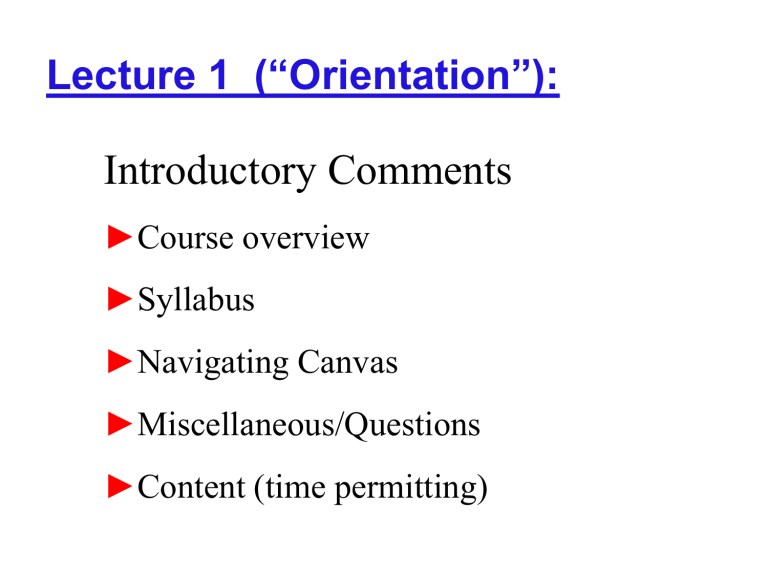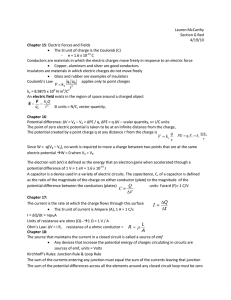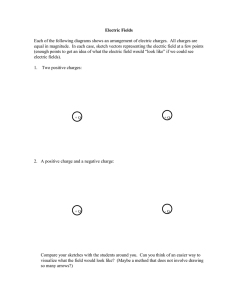
Lecture 1 (“Orientation”): Introductory Comments ►Course overview ►Syllabus ►Navigating Canvas ►Miscellaneous/Questions ►Content (time permitting) Overview of Physics 0175 ► ► This course is part of your “Integrated Curriculum” (calculus, chemistry, engineering, physics) Introductory Physics compressed into two terms (four credits each) Chapter 21: Coulomb’s Law Electric charge Electric charge and the structure of matter Conductors and insulators Induced charge Coulomb’s Law Induced Charges and Shell Theorem Experiments showing that there are two kinds of charges: positive and negative. Like charges repel. Unlike charges attract. Masses & charges of the particles from which atoms are constituted: Electron: me = 9.109 x 10-31 kg qe = - 1.602 x 10-19 C Proton: mp = 1.673 x 10-27 kg qp = + 1.602 x 10-19 C Neutron: mn = 1.675 x 10-27 kg qn = 0.000 C The Millikan oil-drop experiment: A classic series of experiments (1910-1913) that were the first precision determination of the charge of the electron and established the fact that charge was quantized. what does “quantized” mean? Two important principles to remember: Conservation of charge – the algebraic sum of all the electric charges in any closed system is constant Quantization of charge – every observable amount of electric charge is always an integer multiple of the electron charge or the proton charge Conductors vs. insulators: Conductors permit electric charge to move easily. (For example: copper, silver, gold; in fact, most metals) Insulators do not permit electric charge to move easily. (For example: plastic, wood, glass; in fact, most non-metals.) Superconductors and semiconductors: Superconductors offer no resistance at all to the movement of electric charge. (Special alloys at very low temperatures.) Semiconductors allow electric charge to flow under certain conditions, sometimes in one direction but not in the opposite direction. (Insulators that are “doped” with different atoms; very important in modern electronics.) Coulomb’s Law: (1785—Charles Augustin de Coulomb) Electric force between two charges: Direction of F: Magnitude of force: q1 q2 F k 2 r •Attractive if the charges are opposite •Repulsive if the charges are alike k = 8.988 x 109 N•m2/C2 (in S.I. units) The constant k that appears in Coulomb’s Law is often expressed in terms of another, constant ε0 which is called the permittivity of free space (i.e. vacuum): k 1 4 0 8.988 109 9.0 109 N m 2 / C 2 0 8.854 1012 C 2 / N m 2 Electric Force vs. Gravitational Force: Both forces decrease as (1/r2) Both forces are along the line joining the point masses or point charges The electric force is much stronger than the gravitational force for charged particles (recall that G=6.67x10-11 N•m2/kg2 ) The gravitational force is always attractive, while the electric force can be attractive or repulsive Remember Newton’s Third Law: Remember: forces are vectors! Therefore, if a point test charge q0 is surrounded by more than one other point charges q1, q2, q3, … one must calculate the individual force vectors that each of the surrounding charges exerts on the test charge and add these vectors to find the total force: Illustrative Example #2.1: The figure shows four situations in which two charged particles are fixed in place along the x-axis. In which of these four situations is there a point to the left of the particles where an electron will be in equilibrium? Illustrative Example #2.2: The figure shows four configurations of five charged particles evenly spaced along the x-axis. Rank the configurations according to the magnitude of the net electrostatic force on the central particle. Illustrative Example #2.3: What is the net force that q1 and q2 exert on q3? (1-D problem) q1 = +1.0 nC q2 = -3.0 nC q3 = +5.0 nC Remember: forces are vectors! Therefore, if a point test charge q0 is surrounded by more than one other point charges q1, q2, q3, … one must calculate the individual force vectors that each of the surrounding charges exerts on the test charge and add these vectors to find the total force: Vector Addition of Forces Suggested Method: Charging a metal sphere by induction: This would not work if the sphere were not a conductor! Charging a metal sphere by induction: Demo 23d Shell Theorem in Electrostatics: •A shell of uniform charge attracts or repels a charged particle that is outside the shell as if all the shell’s charge were concentrated at its center. •If a charged particle is located inside a shell of uniform charge, there is no net electrostatic force on the particle from the shell. Illustrative Example #3.2: The three configurations shown below all involve a charged particle and a uniformly charged spherical shell. The charges are given and the radii of the shells are indicated. Rank the configurations according to the magnitude of the force on the particle due to the presence of the shell. Where does charge reside on a conductor? If an isolated spherical shell conductor carries a net charge (either positive or negative), the excess charge spreads uniformly over the outer surface of the conductor. Since that surface has the greatest surface area, this allows the like charges to separate as much as possible. If two identical conductors carrying different net charges come into contact, how do their net charges change? Their combined net charge will be divided equally between them. +1e +1e





